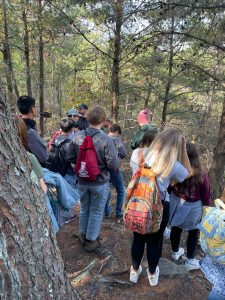A recent trip to Lula Lake was an amazing opportunity for students in both the AP Environmental Science and Agriculture classes to learn about the environment. Lula Lake is a private area on Lookout Mountain, so getting the chance to see it was a unique opportunity for the students.

APES teacher Mrs. Kim Hayen explained how “just about everything about Lula Lake connects to what we learn in APES.” While the area around Lula Lake 100 years ago was a thriving coal mining town, it was eventually abandoned after coal mining operations shut down. People then “used portions of Lula as a dump site and a place to do illegal things,” Hayen said. Due to the negative human impact, Lula Lake was no longer enjoyable anymore. After a new owner began acquiring more and more portions of the property, he eventually created the trust, which Hayen explained is “a legal status which means essentially that the land owns itself, [so] it will be conserved and not developed.” After many years of cleaning, fundraising, and planning, the Lula Lake Land Trust is now “an ecotourism site, a place for people to connect with nature, and . . . a nature preserve.” HHS Media Specialist Mr. Chris Douglass joined the classes on the trip and described the now-reclaimed Lula Lake as “pristine” and a place where “the waters are clear.”
According to Hayen, students in APES “learn about the environment and how humans have had negative impacts, as well as how people can make a positive difference in conserving our natural resources.” Lula Lake Land Trust, she said, is “a great example of both of these topics.” More specifically, students who went on the trip were able to see “an endangered species of plant that lives there, a species of tree that went extinct that scientists are trying to bring back through genetic recombination and propagation, and an invasive species that the forestry service is trying to combat via integrated pest management,” Hayen said. Students were also able to learn about “how businesses and industries are partnering with nature preserves like Lula to combat climate change.” Another thing the students looked forward to was being able to test the water in Rock Creek, a creek on the Lula Lake property. Students in APES regularly do “many scientific tests” on Peavine Creek, the creek behind HHS. The students tested the water’s pH levels, temperature, and water quality. Additionally, Douglass said, the students “were able to go on a hike while we were there and identify different types of trees and different species of plants,” some of which “that are difficult to find, that are–I won’t say ‘endangered’–just not as prevalent in nature.”

Maddy Hall, a Junior Agriculture student and FFA President, said, “It was a great learning experience for all of the Ag kids.” More specifically, Agriculture students “did some stuff with soils that we’re learning in class right now,” Hall said. The Agriculture students also “learned about the trees in class before,” according to Hall, “so it connected with the [invasive] species that was living on the tree.” Hall noted that the Agriculture students were able to learn a lot from the APES students. “It was really a learning experience for all the AG kids because we’ve never been in a class [like APES] . . . and they taught us what they’ve learned [in the class so far].” This trip was an amazing way for students to learn outside of the classroom, and with all of the amazing views of Lookout Mountain it was enjoyable for many students, Junior APES student Daniel Li said, “My favorite part of the trip had to be the hike to the highest part of the mountain.”
“I hope the students appreciated the chance to go outside and see the beautiful waterfall, all of the great fall colors, and they got to soak in the wonderful views on Lookout Mountain,” she said. Douglass agreed, noting that “it was a great day to get out,” since “the leaves are falling [and] the weather was perfect.” He said, “It was neat to get out in nature and to see Heritage students putting what they’ve learned in the classroom . . . into practice in a place that is rejuvenating and keeping the land in a natural form.”







